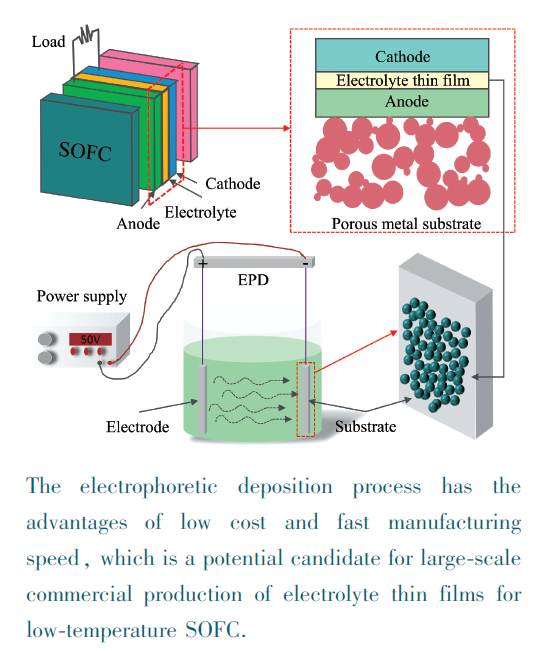 PDF(8403 KB)
PDF(8403 KB)


Electrophoretic Deposition in the Preparation of Electrolyte Thin Films for Solid Oxide Fuel Cells
Bingguo Zhao, Yadi Liu, Haoran Hu, Yangjun Zhang, Zezhi Zeng
Prog Chem ›› 2023, Vol. 35 ›› Issue (5) : 794-806.
 PDF(8403 KB)
PDF(8403 KB)
 PDF(8403 KB)
PDF(8403 KB)
Electrophoretic Deposition in the Preparation of Electrolyte Thin Films for Solid Oxide Fuel Cells
Solid oxide fuel cells (SOFCs) are power generation devices with high efficiency and low emissions. The high operating temperature (700~900 ℃) has impeded the wider adoption of SOFC stacks and limited their lifetime. This has motivated intense research efforts in developing SOFC stacks which can operate at lower temperatures. The thin electrolytes with a thickness smaller than 10 μm could shorten the ion conductive paths and reduce the associated ohmic loss, effectively improving the electrical performance of the low-temperature SOFC. The electrophoretic deposition process has the advantages of low cost and fast manufacturing speed. It is a potential candidate for large-scale commercial production of electrolyte thin films for low-temperature SOFC. In the present article, the research progress of electrophoretic deposition during the past ten years has been summarized. The key results and achievements for the important procedures of the electrophoretic deposition process, which are respectively substrate selection and pretreatment, stable suspension preparation, bubble elimination and heat treatment process, are also discussed and analyzed. The suggestions for future development of the electrophoretic deposition are also provided based on the requirements of large-scale commercialization of thin electrolyte for low-temperature SOFC.
1 Introduction
2 Fundamentals of the electrophoretic deposition process
3 Technical challenges and research progress of electrophoretic deposition process for the preparation of electrolyte thin films
3.1 Substrate selection and pretreatment
3.2 Stable suspension preparation
3.3 Bubble elimination
3.4 Heat treatment process
4 Conclusion and outlook

electrophoretic deposition / dense / electrolyte thin films / intermediate and low temperature / solid oxide fuel cell
| [1] |
|
| [2] |
|
| [3] |
(赵秉国, 曾泽智, 郝长坤, 钱煜平, 诸葛伟林, 张扬军. 工程热物理学报, 2022, 43(11): 3029.).
|
| [4] |
|
| [5] |
|
| [6] |
|
| [7] |
|
| [8] |
|
| [9] |
|
| [10] |
|
| [11] |
|
| [12] |
|
| [13] |
|
| [14] |
|
| [15] |
|
| [16] |
|
| [17] |
|
| [18] |
|
| [19] |
|
| [20] |
|
| [21] |
|
| [22] |
|
| [23] |
(郭意博, 赵哲, 李宇超, 戚惠颖, 程谟杰. 电源技术, 2020, 44(09): 1297.).
|
| [24] |
(杜柯, 宋琛, 余敏, 陈丹, 郭宇, 刘太楷, 杨成浩, 刘敏. 硅酸盐学报, 2022, 50(07): 1929.).
|
| [25] |
|
| [26] |
|
| [27] |
|
| [28] |
|
| [29] |
|
| [30] |
|
| [31] |
|
| [32] |
https://www.webofscience.com/wos/alldb/basic-search.
|
| [33] |
|
| [34] |
|
| [35] |
|
| [36] |
(于静, 张勇, 蒲健, 沈淑馨, 王利捷, 周凡. 热加工工艺, 2018, 47(08): 11.).
|
| [37] |
|
| [38] |
|
| [39] |
|
| [40] |
|
| [41] |
|
| [42] |
|
| [43] |
|
| [44] |
|
| [45] |
|
| [46] |
|
| [47] |
|
| [48] |
|
| [49] |
|
| [50] |
|
| [51] |
|
| [52] |
|
| [53] |
|
| [54] |
|
| [55] |
|
| [56] |
|
| [57] |
|
| [58] |
|
| [59] |
|
| [60] |
|
| [61] |
|
| [62] |
|
| [63] |
|
| [64] |
|
| [65] |
|
| [66] |
|
| [67] |
|
| [68] |
|
| [69] |
|
| [70] |
|
| [71] |
|
| [72] |
|
| [73] |
|
| [74] |
|
| [75] |
|
| [76] |
|
| [77] |
|
| [78] |
|
| [79] |
|
| [80] |
|
| [81] |
|
| [82] |
|
| [83] |
|
| [84] |
|
| [85] |
|
| [86] |
|
| [87] |
|
| [88] |
|
| [89] |
|
| [90] |
|
| [91] |
|
| [92] |
|
| [93] |
|
| [94] |
|
| [95] |
|
| [96] |
|
| [97] |
|
| [98] |
(陈超, 范宏誉, 邢守义, 周细应, 王伟, 袁建辉. 上海金属, 2020, 42(05): 5.).
|
| [99] |
|
| [100] |
|
| [101] |
|
| [102] |
|
| [103] |
|
| [104] |
|
/
| 〈 |
|
〉 |